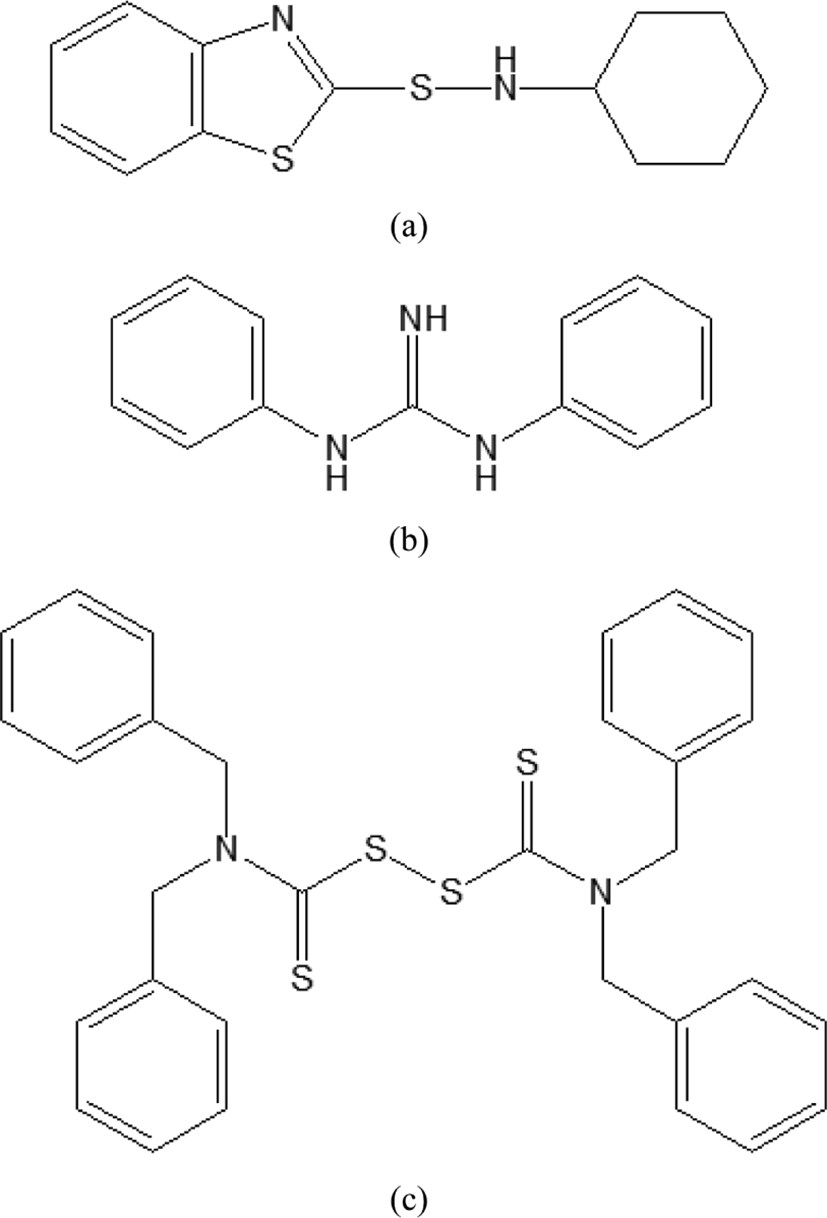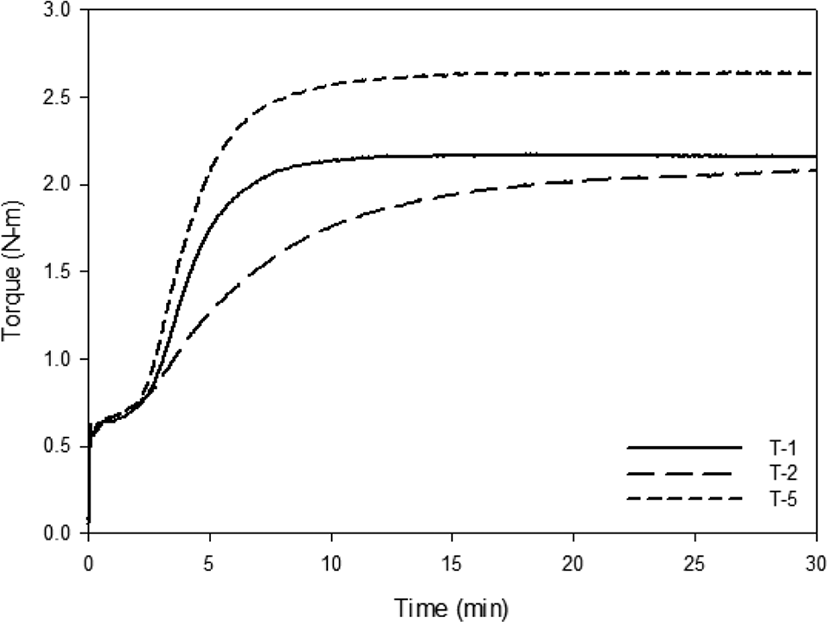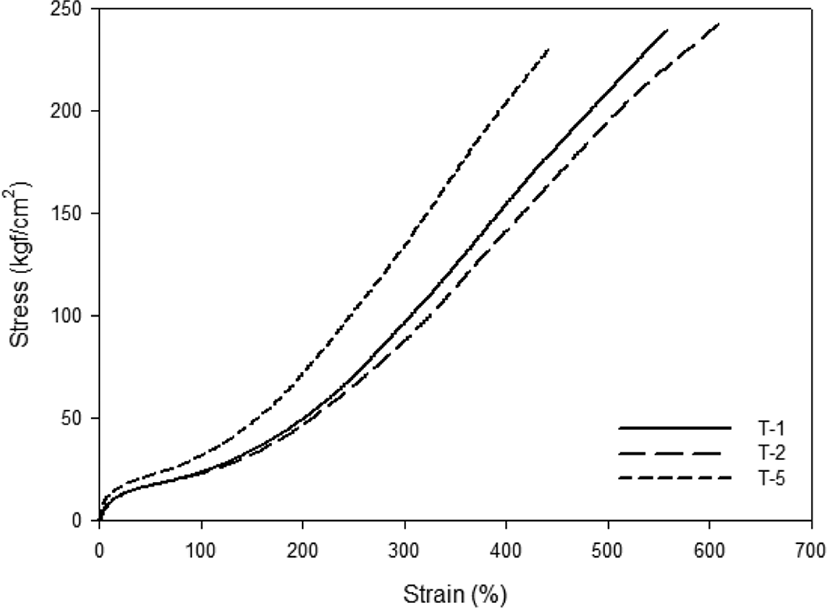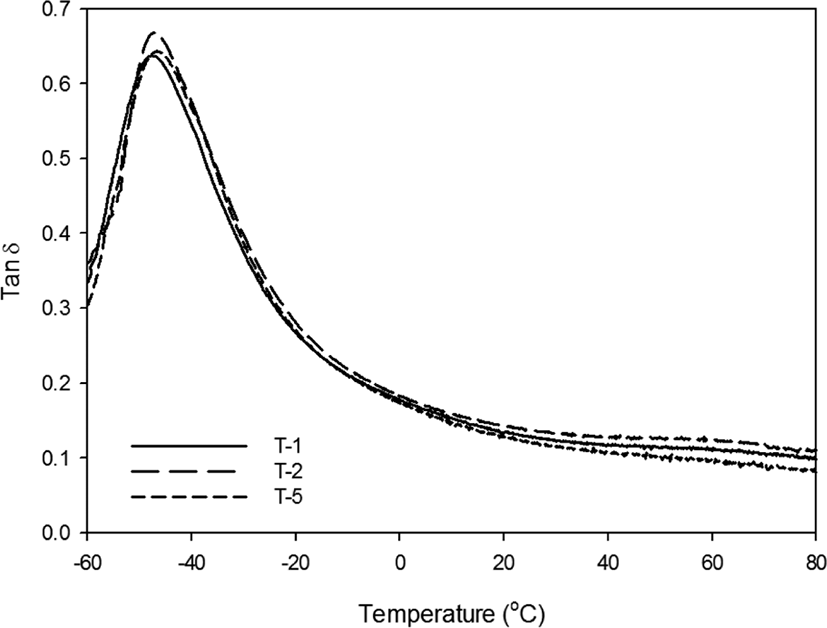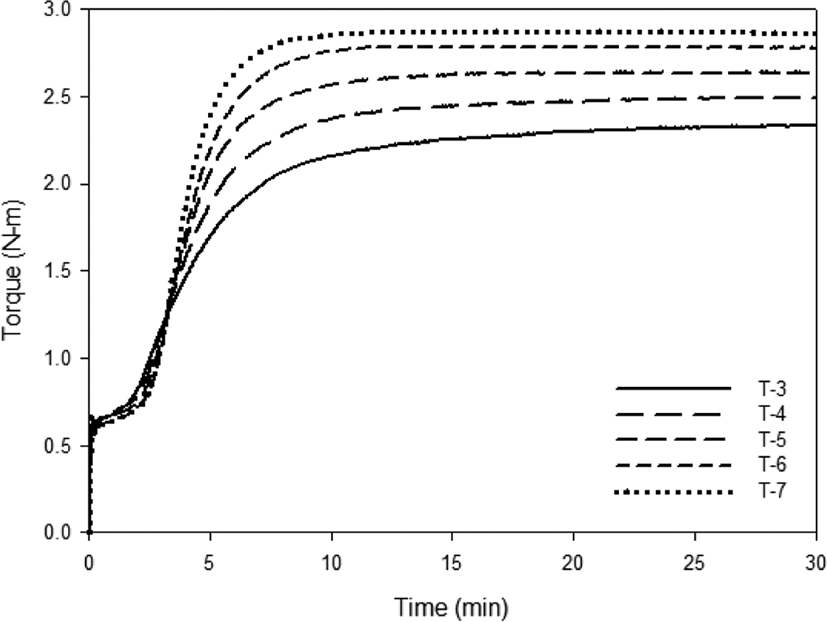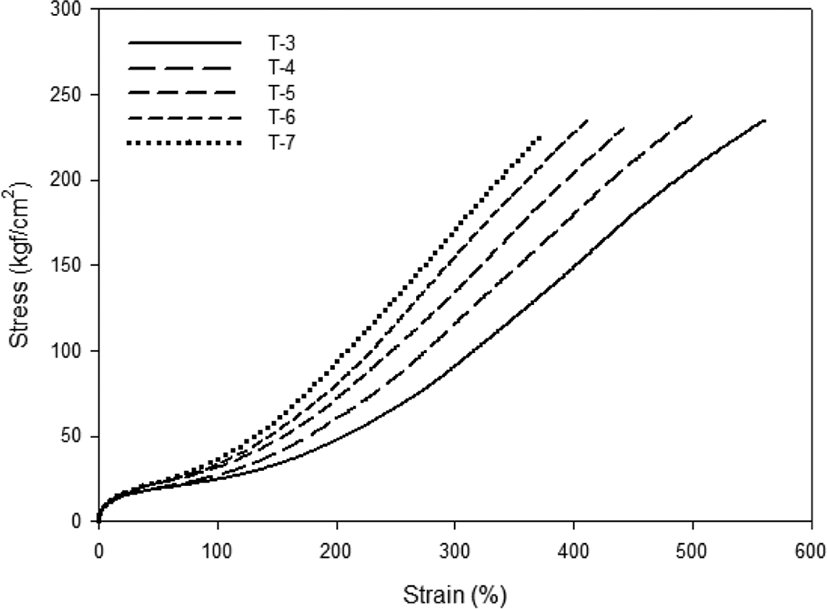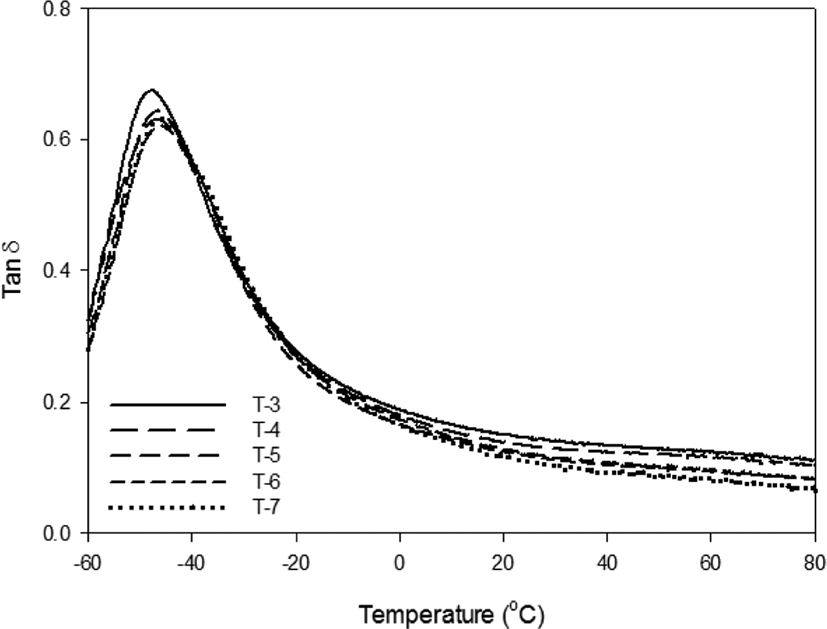Article
Optimization of Cure System for the ESBR Silica WMB and BR Silica DMB Blend Compounds
Eunho Yu1, Woong Kim1, Gyeongchan Ryu1, Byungkyu Ahn1, Hyunsung Mun1, Kiwon Hwang1, Donghyuk Kim1, Wonho Kim1,†
Author Information & Copyright ▼
1Department of Polymer Science & Chemical Engineering, Pusan National University, 2, Busandaehak-ro 63beon-gil, Geumjeong-gu, Busan 46241, Republic of Korea
© Copyright 2019 The Rubber Society of Korea. This is an Open-Access article distributed under the terms of the
Creative Commons Attribution Non-Commercial License (http://creativecommons.org/licenses/by-nc/4.0/) which permits
unrestricted non-commercial use, distribution, and reproduction in any
medium, provided the original work is properly cited.
Received: Mar 26, 2019; Revised: Apr 04, 2019; Accepted: Apr 09, 2019
Published Online: Jul 31, 2019
ABSTRACT
Emulsion styrene-butadiene rubber silica wet masterbatch (ESBR silica WMB) technology was studied to develop highly filled and highly dispersed silica compounds, involving the preparation of a composite by co-coagulating the modified silica and the rubber latex in a liquid phase. Previous studies have shown that when manufacturing ESBR silica WMB/Butadiene silica dry masterbatch (BR silica DMB) blend compounds, preparing BR silica dry masterbatch and mixing it with ESBR silica WMB gave excellent results. However, WMB still has the problem of lower crosslink density due to residual surfactants. Therefore, in this study, tetrabenzylthiuram disulfide (TBzTD) was added instead of diphenyl guanidine (DPG) in the ESBR silica WMB/BR silica DMB blend compounds and sulfur/CBS contents were increased to evaluate their cure characteristics, crosslink densities, mechanical properties, and dynamic viscoelastic properties. TBzTD was found to be more effective in increasing the crosslink density and to produce superior properties compared to DPG. In addition, with increasing sulfur/CBS contents, mechanical properties and rolling resistance were enhanced due to high crosslink density, but the abrasion resistance was not significantly changed because of the toughness.
Keywords: ESBR; Wet masterbatch; Blend compound; Cure system; Crosslink density
Introduction
전 세계적으로 지구온난화 문제가 대두됨에 따라 이산화탄소의 배출량에 대한 규제가 지속적으로 강화되고 있다.1,2 이에 따라 타이어사에서는 승용차용 타이어 트레드 컴파운드의 보강제로 사용되던 카본블랙을 친환경 소재인 실리카로 대체하여 사용하고 있다.3 실리카는 카본블랙 대비 우수한 동적 점탄특성을 나타낸다고 알려져 있으며 마모 성능 및 기계적 물성 등을 더욱 향상시키기 위해 100 phr 이상의 고함량 충진 컴파운드에 대한 연구가 진행되고 있다.4-8 하지만 실리카는 표면에 친수성인 silanol group (Si-OH) 이 존재하여 고무와의 친화성이 떨어지고 고함량 충진 시 가공성이 떨어지며 재응집(re-agglomeration) 현상이 증가하는 문제점이 있다.9-11 이러한 문제점을 해결하기 위해 emulsion styrene-butadiene rubber silica wet masterbatch (ESBR silica WMB) 기술이 개발되고 있다.
ESBR silica WMB는 표면 개질 실리카와 ESBR 라텍스를 수상에서 혼합한 후 응고시켜 고무/표면 개질 실리카 복합체를 제조하는 기술이다.12-14 이는 기존에 고무, 실리카, 실란 커플링제를 mixer 내에서 고온으로 배합하는 과정 중에 silanization 반응으로 실리카의 표면을 개질하는 dry masterbatch (DMB, conventional mixing compound) 방식과 달리 수상에서 혼합되어 분산성이 우수하고 이미 표면 개질이 완료된 실리카를 사용하기 때문에 배합 시 고온의 온도 조건이 필요없으며, silanization 반응의 부산물인 알코올이 발생하지 않는다는 장점이 있다.15
하지만 WMB는 다른 종류의 고무와 blend 컴파운드를 제조하기 힘들다는 단점이 존재한다. 타이어 트레드 컴파운드에 ESBR과 함께 사용하는 대표적인 고무는 butadiene rubber (BR)이다. BR을 ESBR silica WMB와 blend하는 경우에는 ESBR과 표면 개질 실리카가 Van der Waals 인력으로 강하게 결합한 상태이기 때문에 배합 시 BR phase로의 실리카 분산이 어렵다. 이에 따라 컴파운드 내 phase separation 현상이 발생하고, 이는 곧 기계적 물성, 마모 성능, rolling resistance 성능 등이 저하되는 결과로 나타난다.16 이러한 문제점을 해결하기 위해 ESBR silica WMB와 BR silica DMB를 각각 제조한 뒤 혼합하여 phase separation 현상을 완화하고 물성을 확보하는 방법이 제시된 바 있다.17
또 다른 단점으로는 WMB 제조 시 잔류하는 surfactant 문제가 있다. Surfactant는 컴파운드 내에서 실리카의 분산성을 개선시키지만, 가교밀도를 저하시켜 기계적 물성 및 마모 성능이 저하된다는 단점이 있다.15 게다가 surfactant는 실리카에 흡착되는 성질이 있어 효과적으로 제거하기 힘들다.18 이에 따라 ESBR silica WMB/BR silica DMB blend 컴파운드의 황/촉진제 시스템을 조정하여 가교밀도를 향상시키는 연구가 필요하다.
타이어 트레드용 실리카 컴파운드 배합에서 촉진제는 sulfenamide 계열의 N-cyclohexyl benzothiazyl sulfenamide (CBS)와 guanidine 계열의 diphenyl guanidine (DPG)을 보편적으로 사용하고 있다. 이 중 DPG는 amine group이 포함된 염기성 촉진제로, 가황반응에 참여하여 가교밀도를 증가시키는 역할을 할 뿐만 아니라 실리카의 표면과 결합하여 silanization 반응을 촉진하는 역할을 한다고 알려져 있다.19 하지만 WMB는 이미 표면이 개질된 실리카를 사용하므로 DPG가 silanization 반응을 촉진할 필요가 없기 때문에 WMB 컴파운드 배합 시에는 WMB의 단점을 보완할 새로운 2 차 촉진제의 적용이 필요하다.
DPG를 대체할 2차 촉진제로는 thiuram 계열의 초 촉진제인 tetrabenzylthiuram disulfide (TBzTD)가 적용 가능하다. TBzTD는 sulfenamide 계 촉진제와 병용 시 우수한 스코치 안정성, 높은 가교밀도를 나타내고, 고무 컴파운드의 히스테리시스를 감소시켜 우수한 rolling resistance 를 나타내는 것으로 알려져 있다. 하지만 TBzTD를 기존의 DMB 방식에 적용할 경우 미반응 실란 커플링제와 부반응을 일으켜 촉진제의 활성을 잃어버린다는 단점이 존재한다.20 그러나 WMB에 적용할 경우 컴파운드 내 미반응 실란 커플링제가 존재하지 않기 때문에 TBzTD의 효율이 극대화될 것이라 예상된다.
Figure 1.
Chemical structure of cure accelerators: (a) cyclohexyl benzothiazyl sulfenamide (CBS), (b) diphenyl guanidine (DPG),(c) tetrabenzylthiuram disulfide (TBzTD).
Download Original Figure
따라서 본 연구에서는 ESBR silica WMB/BR silica DMB blend 컴파운드에 황과 CBS 및 DPG를 각 각 1.5 phr 적용한 컴파운드 대비 DPG를 0.1 phr로 감량하고 TBzTD를 0.25 phr적용한 컴파운드의 물성을 측정하였으며, 마모 성능 개선을 위한 최적 가교밀도를 확인하고자 황과 CBS를 1.0 phr에서 2.0 phr까지 0.25 phr 단위로 변량하여 고무 컴파운드의 물성 평가를 진행하였다.
Experimental
1. 실험 재료
ESBR silica WMB 제조를 위해 SBR-1712 (Kumho Petro-chemical Co., styrene content: 23.5%, non-oil extend)와 BR silica DMB 제조를 위해 NdBR40 (Kumho Petrochemical Co., cis 1,4 content: < 97%), treated distillate aromatic extracted oil (TDAE oil)를 사용하였으며 공통적으로 8 wt%의 bis[3-(triethoxysilyl)propyl]tetrasulfide (TESPT)가 표면 처리된 표면개질실리카 NK136 (Mirae SI Inc., BET surface area: 126 m2/g)을 사용하였다. Zinc 2-ethylhexanoate (ZEH)는 가공조제, 40 MSF (Struktol Co.)는 이종 고무 혼합제로 사용하였고, zinc oxide (ZnO)와 stearic acid는 가교 활성제, (1,3-dimethybutyl)-N’-phenyl-p-phenylenediamine (6PPD)은 산화방지제로 사용하였다. 가교 시스템은 가교제인 황과 함께 1차 촉진제로 N-cyclohexyl benzothiazyl sulfenamide (CBS), 2차 촉진제로 diphenyl guanidine (DPG) 및 tetrabenzylthiuram disulfide (TBzTD)를 사용하였다. 가교밀도 평가에는 tetrahydrofuran (THF, Daejung Chemicals & Metal), n-hexane (Daejung Chemicals & Metal), toluene (Daejung Chemicals & Metal)을 용매로 사용하였다.
2. ESBR silica WMB의 제조
실리카 대비 8 wt%의 TESPT로 표면 개질된 실리카 81 phr을 증류수 1L에 첨가하고 70℃에서 15분간 교반한 뒤 75 phr의 고체 ESBR을 함유하는 SBR-1712 latex와 혼합하여 30분동안 추가로 교반하였다. 이후 2 wt% CaCl2 수용액 300 ml를 응집제로 사용하여 WMB를 응고하였으며 응고된 ESBR silica WMB는 증류수로 4회 세척한 후 convection oven에서 50℃에서 24시간 동안 건조시켰다. 자세한 제조 recipe는 Table 1에 나타내었다.
Table 1.
Recipe of ESBR Silica WMB
| Unit: phr |
Content |
| 1712 ESBR |
75 |
| Modified silica (NK136) |
81 |
| Total |
156 |
Download Excel Table
3. BR silica DMB의 제조
BR silica DMB는 밀폐식 혼합기(MiraeSI Inc., kneader, 300cc)를 사용하여 제조하였다. 초기 온도를 110℃로 설정하여 NdBR40 25 phr과 TDAE oil 20 phr, 8% TESPT modified silica 27 phr을 투입한 후 5분 40초간 배합을 진행하여 BR silica DMB를 제조하였다.
4. 컴파운드의 제조
컴파운드는 BR silica DMB와 마찬가지로 밀폐식 혼합기를 사용하여 제조되었고 2 단계에 걸쳐 진행하였다. 1단계에서는 혼합기의 온도를 120℃로 설정하고 dump 온도를 150℃로 맞추어 12분 동안 배합을 진행했으며, 2단계에서는 초기 온도를 50℃로 설정하여 2분 동안 배합을 진행하였다. 자세한 컴파운드의 formulation및 배합 과정은 Table 2, Table 3에 각 각 나타내었다.
Table 2.
Formulations of ESBR Silica WMB/BR Silica DMB Blend Compounds.
| Unit: phr |
T-1 |
T-2 |
T-3 |
T-4 |
T-5 |
T-6 |
T-7 |
| Step 1 |
ESBR silica WMB |
|
|
|
156A |
|
|
|
| BR silica DMB |
|
|
|
72B |
|
|
|
| 40 MSF |
|
|
|
3 |
|
|
|
| ZEH |
|
|
|
3 |
|
|
|
| ZnO |
|
|
|
3 |
|
|
|
| Stearic acid |
|
|
|
2 |
|
|
|
| 6PPD |
|
|
|
1 |
|
|
|
| Step 2 |
DPG |
1.5 |
0.1 |
0.1 |
0.1 |
0.1 |
0.1 |
0.1 |
| TBzTD |
0 |
0 |
0.25 |
0.25 |
0.25 |
0.25 |
0.25 |
| Sulfur |
1.50 |
1.50 |
1.0 |
1.25 |
1.50 |
1.75 |
2.0 |
| CBS |
1.50 |
1.50 |
1.0 |
1.25 |
1.50 |
1.75 |
2.0 |
Download Excel Table
Table 3.
Compounding Procedure for the ESBR Silica WMB/BR Silica DMB Blend Compounds
|
|
Time (min) |
Action |
RPM |
| Step 1 (120°C) |
0:00 |
ESBR silica WMB, BR silica DMB, ZEH, 40MSF |
20 |
| 0:40 |
RPM up |
40 |
| 5:40 |
ZnO, St/A, 6PPD |
50 |
| 12:00 |
Dump |
50 |
| Step 2(50°C) |
0:00 |
Mix 1st MB |
20 |
| 0:20 |
Sulfur, cure accelerator (CBS, DPG, TBzTD) |
50 |
| 2:00 |
Dump |
50 |
Download Excel Table
4.1. 가황특성(cure characteristics) 측정
제조가 완료된 컴파운드의 가황특성은 moving die rheometer (RLR-3; rotorless rheometer, Toyoseiki, Japan)를 진동각 ±1°, 온도 160℃ 조건으로 30분간 시편에 가해지는 토크 값, scorch time (t10) 및 최적가황시간(t90)을 측정하였다.
4.2. 가교밀도(crosslink density) 측정
10 mm × 10 mm 크기로 가교된 시편을 자른다. THF (30 mL), n-hexane (30 mL)을 용매로 각 각 2일과 1일간 침지시켜 유기 첨가물을 제거하고 실온에서 1일간 건조시킨다. 건조가 완료된 샘플의 질량을 측정한 뒤 toluene (30 mL)에 24시간 동안 팽윤시킨다. 이후 팽윤된 샘플의 질량을 측정하고 아래의 Flory-Rehner equation을 이용해 전체 가교밀도를 계산하였다.
χ: polymer-solvent interaction parameter (0.34)
v: crosslink density (mol/g)
Mc: average molecular weight between crosslink points (g/mol)
V1: volume fraction of rubber in thr swollen gel at equilibrium
V0: molar volume of solvent (cm3/mol)
ρr: density of the rubber sample (g/cm3).
4.3. 기계적 특성(mechanical properties) 측정
컴파운드의 기계적 특성은 ASTM D412에 따라 측정하였다. 100 mm (길이) × 25 mm (너비) × 2 mm (두께)의 아령형 시편을 제작한 후 universal testing machine (UTM, KSU-05M-C, KSU Co., Korea)을 이용하여 연신율, 인장강도 및 modulus값을 측정하였다.
4.4. 마모 특성(abrasion properties) 측정
컴파운드의 마모 특성은 ASTM D5963에 따라 DIN 마모시험기(KST, DIN abrasion tester)를 이용하여 측정하였다. 직경 16 mm, 두께 8 mm의 실린더형 샘플을 제조하였고, 연마포가 부착된 원통 모양의 드럼을 5N의 수직 하중 하에서 40±1 rpm의 속도로 회전시켜 마모 후 시편의 질량 감소량을 측정하였다.
4.5. 동적 점탄특성(dynamic viscoelastic properties) 측정
컴파운드의 동적 점탄특성은 dynamic mechanical analyzer (DMA, Q800, TA instrument, USA)를 이용하여 ASTM D4065 조건으로 온도에 따른 tan δ 값을 측정하였다. 측정된 tan δ 값으로부터 가류물의 tanδ at 60℃ (rolling resistance index) 값을 구하였다.
Results and Discussion
1. ESBR silica WMB/BR silica DMB blend 컴파운드의 DPG/TBzTD 함량 조절
1.1. DPG/TBzTD 함량 조절 컴파운드의 가황특성 측정 결과
T-1, T-2, T-5 컴파운드의 가황특성 측정결과를 Figure 3과 Table 4에 나타냈다. 2개 이상의 촉진제를 사용할 시, salt 형태의 complex를 형성하는데 이 complex는 촉진제를 각각 사용할 때보다 활성을 높인다는 연구 결과가 존재한다.21 이에 따라 DPG가 감량된 T-2 컴파운드는 가황반응의 활성이 낮아서 cure rate, Tmax-Tmin 값이 감소하고 marching 현상이 발생하였다. 그에 반해 T-5 컴파운드의 경우 DPG를 감량하였음에도 불구하고 TBzTD를 처방하여 빠른 cure rate 를 나타 냈으며 높은 Tmax-Tmin 값이 나타난다. 이는 thiuram 계열 촉진제인 TBzTD의 가황반응 중 dithiocarbamate radical (R2N(C=S)S’)과 persulfenyl radical (R2N(C=S)SSx’)이 반응성이 우수한 공명 구조를 이루어 고무의 이중결합과 빠르게 반응하기 때문이다.22 또한 TBzTD가 초 촉진제임에도 불구하고 스코치 안정성 또한 충분히 확보된 것을 확인할 수 있는데, 이는 TBzTD가 CBS와 TBzTD/amine 또는 TBzTD/benzothiozole 복합체를 형성하여 가황반응의 경쟁적 억제반응이 일어나기 때문이다.23
Table 4.
Cure Characteristics of the Compounds by Controlling DPG/TBzTD Content
|
|
T-1 |
T-2 |
T-5 |
| t10 (min) |
2:01 |
1:36 |
2:11 |
| t90 (min) |
6:57 |
14:29 |
7:12 |
| Cure rate (N-m/min) |
0.43 |
0.14 |
0.49 |
| Tmin (N-m) |
0.56 |
0.55 |
0.58 |
| Tmax (N-m) |
2.17 |
2.08 |
2.64 |
| Tmax-Tmin (N-m) |
1.61 |
1.53 |
2.07 |
Download Excel Table
1.2. DPG/TBzTD 함량 조절 컴파운드의 가교밀도 측정 결과
가교밀도의 정량적 측정 결과를 Table 5에 나타냈다. 결과는 가황특성의 Tmax-Tmin 값의 경향과 유사하게 나타난다. DPG를 감량한 T-2 컴파운드의 경우 촉진제의 활성이 낮아서 T-1 컴파운드 대비 낮은 가교밀도가 나타나는 반면, T-5 컴파운드의 경우에는 TBzTD가 DPG 대신 2차 촉진제로써 역할을 수행하여 높은 가교밀도를 나타낸 것으로 판단된다.
Table 5.
Crosslink Densities of the Compounds by Controlling DPG/TBzTD Content
|
|
T-1 |
T-2 |
T-5 |
| Crosslink density (10−4mol/g) |
0.876 |
0.778 |
1.340 |
Download Excel Table
1.3. DPG/TBzTD 함량 조절 컴파운드의 기계적 특성 측정 결과
기계적 특성 결과를 Figure 4와 Table 6에 나타냈다. DPG를 감량한 T-2 컴파운드는 가교밀도가 낮아 hardness와 300% modulus가 감소했다. T-5 컴파운드는 TBzTD의 우수한 활성에 의해 높은 가교밀도를 나타내어 hardness와 300% modulus가 크게 증가한 것을 확인할 수 있다.
Table 6.
Mechanical Properties of the Compounds by Controlling DPG/TBzTD Content
|
|
T-1 |
T-2 |
T-5 |
| Hardness (Shore A) |
67 |
66 |
71 |
| M300% (kgf/cm2) |
96.6 |
87.9 |
134.3 |
| Elongation at break (%) |
558 |
615 |
440 |
| Tensile strength (kgf/cm2) |
239 |
244 |
230 |
| Toughness (kgf*%/cm2) |
56,000 |
65,200 |
43,200 |
Download Excel Table
1.4. DPG/TBzTD 함량 조절 평가의 마모 특성 측정 결과
DIN 마모시험에서 확인할 수 있는 마모 mechanism은 크게 두 가지가 있다. 첫 번째는 마모가 진행되는 표면에서부터 crack이 생성되고, 생성된 crack이 점차적으로 전파되는 mechanical fatigue이며, 이러한 mechanism은 가교밀도에 크게 영향을 받는다. 두 번째로는 시편에 가해지는 마찰력에 의해 직접적으로 시편이 파단되는 direct tearing이 있으며, 이 때의 mechanism은 가교밀도가 높을수록 마모 성능이 저하될 우려가 있으며, toughness와 같은 성질에 영향을 받는다고 알려져 있다.24,25 Table 7에 나타난 DIN 마모 측정 결과에 따르면, 기계적 특성에 나타낸 toughness 값과는 관계 없이 가교밀도가 높은 T-5, T-1, T-2 순서대로 마모 성능이 우수한 것을 확인할 수 있으며, 이는 본 실험에서 mechanical fatigue가 지배적인 마모 mechanism인 것으로 판단된다.
Table 7.
DIN abrasion Loss of the Compounds by Controlling DPG/TBzTD Content
|
|
T-1 |
T-2 |
T-5 |
| DIN abrasion loss (mg) |
104.5 |
113.8 |
80.5 |
Download Excel Table
1.5. DPG/TBzTD 함량 조절 컴파운드의 동적 점탄특성 측정 결과
동적 점탄특성 측정 결과를 Figure 5와 Table 8에 나타냈다. DMA 측정을 통하여 온도에 따른 tan δ 값을 측정한 결과, rolling resistance의 척도인 tan δ at 60°C 값이 T-5, T-1, T-2 순서대로 낮게 나타났다. 컴파운드의 hysteresis는 고분자 사슬 말단의 mobility에 의해 발생하며 이러한 mobility는 가교 결합에 의해서 제한받을 수 있다.26-28 따라서 가교밀도가 높을수록 전반적인 tan δ 값이 낮게 나타났고, 이는 가교밀도가 높을수록 rolling resistance가 개선된다는 것을 의미한다.
Figure 5.
Tan δ curves of the compounds by controlling DPG/TBzTD content as a function of temperature.
Download Original Figure
Table 8.
Dynamic viscoelastic Properties of the Compounds by Controlling DPG/TBzTD Content
|
|
T-1 |
T-2 |
T-5 |
| Tan δ at 60°C |
0.1109 |
0.1237 |
0.0992 |
Download Excel Table
2. ESBR silica WMB/BR silica DMB 컴파운드의 황/CBS 변량 평가
2.1. 황/CBS 변량 컴파운드의 가황특성 측정 결과
T-3~T-7 컴파운드의 가황특성 측정 결과를 Figure 6과 Table 9에 나타냈다. 황과 CBS의 투입량이 늘어날수록 가교밀도가 증가하여 때문에 높은 Tmax-Tmin 값을 나타냈다. 1차 촉진제인 CBS는 컴파운드에 존재하는 Zn2+ 이온과 반응하여 가황반응을 촉진한다.29 이에 따라, CBS를 함께 증량 처방할수록 cure rate 값이 증가하는 것을 알 수 있다. T-3 컴파운드는 CBS의 투입량이 적어서 marching 현상이 나타났고, 이에 따라 불완전한 가황반응이 일어났을 것이라 판단된다.
Table 9.
Cure Characteristics of the Compounds by Changing Sulfur/CBS Content
|
|
T-3 |
T-4 |
T-5 |
T-6 |
T-7 |
| t10 (min) |
1:38 |
2:01 |
2:11 |
2:23 |
2:29 |
| t90 (min) |
9:57 |
8:25 |
7:12 |
6:43 |
6:04 |
| Cure rate (N-m/min) |
0.26 |
0.36 |
0.49 |
0.59 |
0.77 |
| Tmin (N-m) |
0.56 |
0.60 |
0.58 |
0.56 |
0.58 |
| Tmax (N-m) |
2.34 |
2.50 |
2.64 |
2.79 |
2.88 |
| Tmax-Tmin (N-m) |
1.78 |
1.90 |
2.07 |
2.23 |
2.30 |
Download Excel Table
2.2. 황/CBS 변량 컴파운드의 가교밀도 측정 결과
가교밀도의 정량적 측정 결과를 Table 10에 나타냈다. 황과 CBS를 증량할수록 가황반응에 참여하는 황이 많아지고 큰 반응성을 나타내기 때문에 가교밀도가 선형적으로 증가하며, 가황특성에서의 Tmax-Tmin 값과 경향이 일치한다.
Table 10.
Crosslink Densities of the Compounds by Changing Sulfur/CBS Content
|
|
T-3 |
T-4 |
T-5 |
T-6 |
T-7 |
| Crosslink density (10-4 mol/g) |
1.04 |
1.20 |
1.34 |
1.48 |
1.65 |
Download Excel Table
2.3. 황/CBS 변량 컴파운드의 기계적 특성 측정
기계적 특성 결과를 Figure 7과 Table 11에 나타냈다. 황 및 CBS를 증량 처방함에 따라 가교밀도가 선형적으로 증가하여 hardness, 300% modulus 값 역시 증가하는 것을 알 수 있고, 그에 반해 elongation at break 값이 점차적으로 감소하여 toughness 값 역시 감소하는 것을 알 수 있다.
Table 11.
Mechanical Properties of the Compounds by Changing Sulfur/CBS Content
|
|
T-3 |
T-4 |
T-5 |
T-6 |
T-7 |
| Hardness (Shore A) |
69 |
70 |
71 |
72 |
73 |
| M300% (kgf/cm2) |
90.8 |
115.3 |
134.3 |
154.9 |
170.7 |
| Elongation at break (%) |
560 |
500 |
440 |
410 |
370 |
| Tensile strength (kgf/cm2) |
240 |
240 |
230 |
240 |
230 |
| Toughness (kgf*%/cm2) |
55,300 |
51,100 |
43,200 |
41,400 |
35,900 |
Download Excel Table
2.4. 황/CBS 변량 컴파운드의 마모 특성 측정
DIN 마모 측정 결과를 Table 12에 나타냈다. T-3 컴파운드의 경우에는 marching 현상이 발생하여 가교밀도가 낮아 불리한 결과를 나타냈다. T-4~T-7 컴파운드는 유사한 마모 성능을 나타낸다. 앞서 언급한 바와 같이, 마모 mechanism은 mechanical fatigue와 direct tearing으로 크게 두 가지가 존재한다. T-3, T-4 컴파운드의 마모 성능 차이는 가교밀도에 기인한다고 할 수 있다. 하지만 T-4~T-7 컴파운드를 비교해보면 가교밀도가 증가함에도 마모 성능에 큰 변화가 없음을 확인할 수 있는데, 이는 마모 mechanism이 mechanical fatigue에서 direct tearing으로 전환되는 구간이기 때문이다. 황과 CBS의 함량이 높은 컴파운드일수록 마모 mechanism이 direct tearing에 가까워지고, 이에 따라 높은 가교밀도임에도 불구하고 toughness 값이 감소하기 때문에 마모 성능이 향상되지 않는 결과를 보인다.24,25 더 나아가서, 황 및 CBS를 T-7 컴파운드의 투입량인 2.0phr을 초과하여 투입한다면 마모 성능이 점차 감소하는 구간이 존재할 것이라고 예상된다.
Table 12.
DIN abrasion Loss of the Compounds by Changing Sulfur/CBS Content
|
|
T-3 |
T-4 |
T-5 |
T-6 |
T-7 |
| DIN abrasion loss (mg) |
85.3 |
80.5 |
79.8 |
79.5 |
78.5 |
Download Excel Table
2.5. 황/CBS 변량 컴파운드의 동적 점탄특성 측정
온도에 따른 tan δ 값을 구한 동적 점탄특성 측정 결과를 Figure 8과 Table 13에 나타냈다. 앞서 언급한 바와 같이, 고분자 사슬 말단의 mobility가 hysteresis를 유발한다고 알려져 있다. 따라서 가교밀도가 높아질수록 고분자 사슬 말단의 mobility가 제한받고,26-28 앞선 결과와 마찬가지로 tan δ at 60°C 값이 낮아졌다. 본 결과는 황과 CBS를 증량할수록 rolling resistance가 개선된다는 것을 의미한다.
Table 13.
Dynamic viscoelastic Properties of the Compounds by Changing Sulfur/CBS Content
|
|
T-3 |
T-4 |
T-5 |
T-6 |
T-7 |
| Tan δ at 60°C |
0.1261 |
0.1166 |
0.0990 |
0.0942 |
0.0833 |
Download Excel Table
Conclusion
표면 개질이 완료된 실리카를 사용하는 WMB는 DMB와는 달리 DPG가 silanization 반응을 촉진할 필요가 없기 때문에 기존의 DMB 컴파운드와 다른 가교 시스템을 적용해야한다. 이에 따라 DPG를 대체할 2차 촉진제로는 CBS와 병용 시 scorch safety가 확보되며 WMB 컴파운드 제조 시 미반응 TESPT와의 부반응을 일으킬 우려가 없는 TBzTD를 처방하여 DPG를 사용한 기존의 가교 시스템을 적용한 컴파운드와 비교 평가하였다. 그 결과 TBzTD의 우수한 반응성으로 인해 가황특성에서 빠른 cure rate, 높은 토크 변화량 및 우수한 가교밀도를 얻을 수 있었다. 이에 따라 기계적 특성, 마모 특성 및 rolling resistance 측면에서 우수한 결과를 얻을 수 있었다.
또한 가교밀도의 증가에 따른 물성 변화를 확인하기 위해 가교제인 황과 1차 촉진제인 CBS를 1.0 phr부터 2.0 phr까지 0.25 phr 단위로 변량하여 물성 평가를 진행하였다. 그 결과, 황과 CBS가 증량이 될수록 빠른 가황특성을 나타내고 가교밀도가 선형적으로 증가하여 기계적 특성, rolling resistance 측면에서 우수한 결과를 나타냈다. 하지만 마모 성능은 황과 CBS가 1.0 phr에서 1.25 phr로 증량될 때에는 개선되지만 toughness의 감소로 인해 1.25 phr 이상 투입 시 성능 변화가 미미했다.
Acknowledgements
This work was supported from Minister of Trade, Industry and Energy Grant funded by the Korean Government [Project Number 10067128] and BK21 PLUS Centre for Advanced Chemical Technology [21A20131800002], Republic of Korea.
References
G. Santos, “Road Transport and CO
2 Emissions: What are the Challenges?”,
Transport Policy,
59, 71 (2017).


N. Rivers and R. Wigle, “An Evaluation of Policy Options for Reducing Greenhouse Gas Emissions in the Transport Sector: The Cost-Effectiveness of Regulations Versus Emissions Pricing”
Laurier Centre for Economic Research and Policy Analysis Working Papers,
107 (2018).

S. Wolff, “Chemical Aspects of Rubber Reinforcement by Fillers”,
Rubber Chemistry and Technology,
69, 3 (1996).


C. M. Flanigan, L. Beyer, D. Klekamp, D. Rohweder, B. Stuck, and E. R. Terrill, “Comparative Study of Silica, Carbon Black and Novel Fillers in Tread Compounds”,
Rubber World,
245, 5 (2012).

J. W. Ten Brinke, S. C. Debnath, L. A. Reuvekamp, and J. W. Noordermeer, “Mechanistic Aspects of The Role of Cou-pling Agents in Silica–Rubber Composites”,
Composites Science and Technology,
63, 8 (2003).


T. Xu, Z. Jia, S. Wang, Y. Chen, Y. Luo, D. Jia, and Z. Peng, “Self-Crosslinkable Epoxidized Natural Rubber-Silica Hybrids”,
Journal of Applied Polymer Science,
134, 14 (2017).


H. D. Luginsland, J. Frohlich, and A. Wehmeier, “Influence of Different Silanes on the Reinforcement of Silica-Filled Rubber Compounds”,
Rubber Chemistry and Technology,
75, 4 (2002).


S. S. Choi, “Influence of the Silica Content on Rheological Behaviour and Cure Characteristics of Silica-Filled Styrene-Butadiene Rubber Compounds”,
Polymer International,
50, 5 (2001).


W. Kaewsakul, K. Sahakaro, W. K. Dierkes, and J. W. Noordermeer, “Optimization of Mixing Conditions for Silica-Reinforced Natural Rubber Tire Tread Compounds”,
Rubber Chemistry and Technology,
85, 2 (2012).


Y. Gui, J. Zheng, X. Ye, D. Han, M. Xi, and L. Zhang, “Preparation and Performance of Silica/SBR Masterbatches with High Silica Loading by Latex Compounding Method”,
Composites Part B: Engineering,
85 (2016).


K. J. Kim and J. VanderKooi, “Moisture Effects on TESPD-Silica/CB/SBR Compounds”,
Rubber Chemistry and Technology,
78, 1 (2005).


Y. Wang, L. Liao, J. Zhong, D. He, K. Xu, C. Yang, Y. Luo, and Z. Peng, “The Behavior of Natural Rubber-Epoxidized Natural Rubber-Silica Composites Based on Wet Masterbatch Technique”,
Journal of Applied Polymer Science,
133, 26 (2016).


J. W. Lightsey, D. J. Kneiling, and J. M. Long, “Silica Wet Masterbatch: A New Process For Pre-Dispersion of Silica in Emulsion Polymers”,
Rubber World,
218, 3 (1998).

C. Yin, Q. Zhang, and D. Gong, “Preparation and Properties of Silica/Styrene Butadiene Rubber Masterbatches by Latex Co-Coagulating Technology”,
Polymer Composites,
35, 6 (2014).


W. Kim, B. Ahn, H. Mun, E. Yu, K. Hwang, D. Kim, G. Ryu, and W. Kim, “Effect of Calcium Chloride as a Coagulant on the Properties of ESBR/Silica Wet Masterbatch Compound”,
Polymers,
10, 10 (2018).




E. M. Sadek, D. E. El-Nashar, and S. M. Ahmed, “Effect of Organoclay Reinforcement on the Curing Characteristics and Technological Properties of Styrene-Butadiene Rubber”,
Polymer Composites,
36, 7 (2015).


W. Kim, B. Ahn, H. Moon, E. Yu, K. Hwang, and W. Kim, “Evaluation of BR Blending Methods for ESBR/Silica Wet Masterbatch Compounds”,
Elastomers and Composites,
52, 4 (2017).

K. Hwang, W. Kim, B. Ahn, H. Mun, E. Yu, D. Kim, G. Ryu, and W. Kim, “Effect of Surfactant on the Physical Properties and Crosslink Density of Silica Filled ESBR Compounds and Carbon Black Filled Compounds”,
Elastomers and Composites,
53, 2 (2018).

C. Hayichelaeh, L. A. E. M. Reuvekamp, W. K. Dierkes, A. Blume, J. W. M. Noordermeer, and K. Sahakaro, “Enhancing the Silanization Reaction of the Silica-Silane System by Different Amines in Model and Practical Silica-Filled Natural Rubber Compounds”,
Polymers,
10, 6 (2018).




R. N. Datta, A. G. Talma, S. Datta, P. G. J. Nieuwenhuis, W. J. Nijenhuis, and W. Maslow, “On The Chemistry of Tetra-benzyl Thiuram Disulfide and Tetramethyl Thiuram Disulfide with Bis (Triethoxysilylpropyl) Tetrasulfide in Silica Compounds”,
Rubber Chemistry and Technology,
76, 4 (2003).


S. Minatoya, K. Kojima, and I. Nagai, “Studies on the Combined Use of Two Different Accelerators. I. Diphenylguanidine and Mercaptobenzothiazole”,
Rubber Chemistry and Technology,
5, 4 (1932).


M. M. Coleman, J. R. Shelton, and J. K. Koening, “Raman and ESR Spectroscopic Studies of Accelerator Systems. I. Raman Spectra of Thiuram Sulfides and Related Compounds”,
Rubber Chemistry and Technology,
46, 4 (1973).


M. York, “Efficiency Cure Accelerator/Mercapto-Type Silane Combination: Improved Rolling Resistance Without Wet Traction Loss through Competitive Inhibition”, 188th Technical meeting of Rubber Division, ACS (Cleveland, OH), Oct 14th (2015).

K. Cho and D. Lee, “Effect of Molecular Weight Between Cross-Links on the Abrasion Behavior of Rubber by a Blade Abrader”,
Polymer,
41, 1 (2000).


K. Reincke, W. Grellmann, R. Lach, and G. Heinrich, “Toughness Optimization of SBR Elastomers-Use of Fracture Me-chanics Methods for Characterization”,
Macromolecular Materials and Engineering,
288, 2 (2003).


A. Mousa, U. S. Ishiaku, and Z. A. Mohd Ishak, “Rheological and Viscoelastic Behavior of Dynamically Vulcanized Poly (Vinyl Chloride)-Epoxidized Natural-Rubber Thermoplastic Elastomers”,
Journal of Applied Polymer Science,
74, 12 (1999).


S. S. Choi, “Improvement of Properties of Silica-Filled Styrene-Butadiene Rubber Compounds Using Acrylonitrile-Butadiene Rubber”,
Journal of Applied Polymer Science,
79, 6 (2001).


T. Kataoka, P. B. Zetterlund, and B. Yamada, “Effects of storage and service on tire performance: Oil component content and swelling behavior”,
Rubber Chemistry and Technology,
76, 2 (2003).


A. Y. Coran, “Vulcanization. PART VII. Kinetics of Sulfur Vulcanization of Natural Rubber in Presence of Delayed-Action Accelerators”,
Rubber Chemistry and Technology,
38, 1 (1965).


